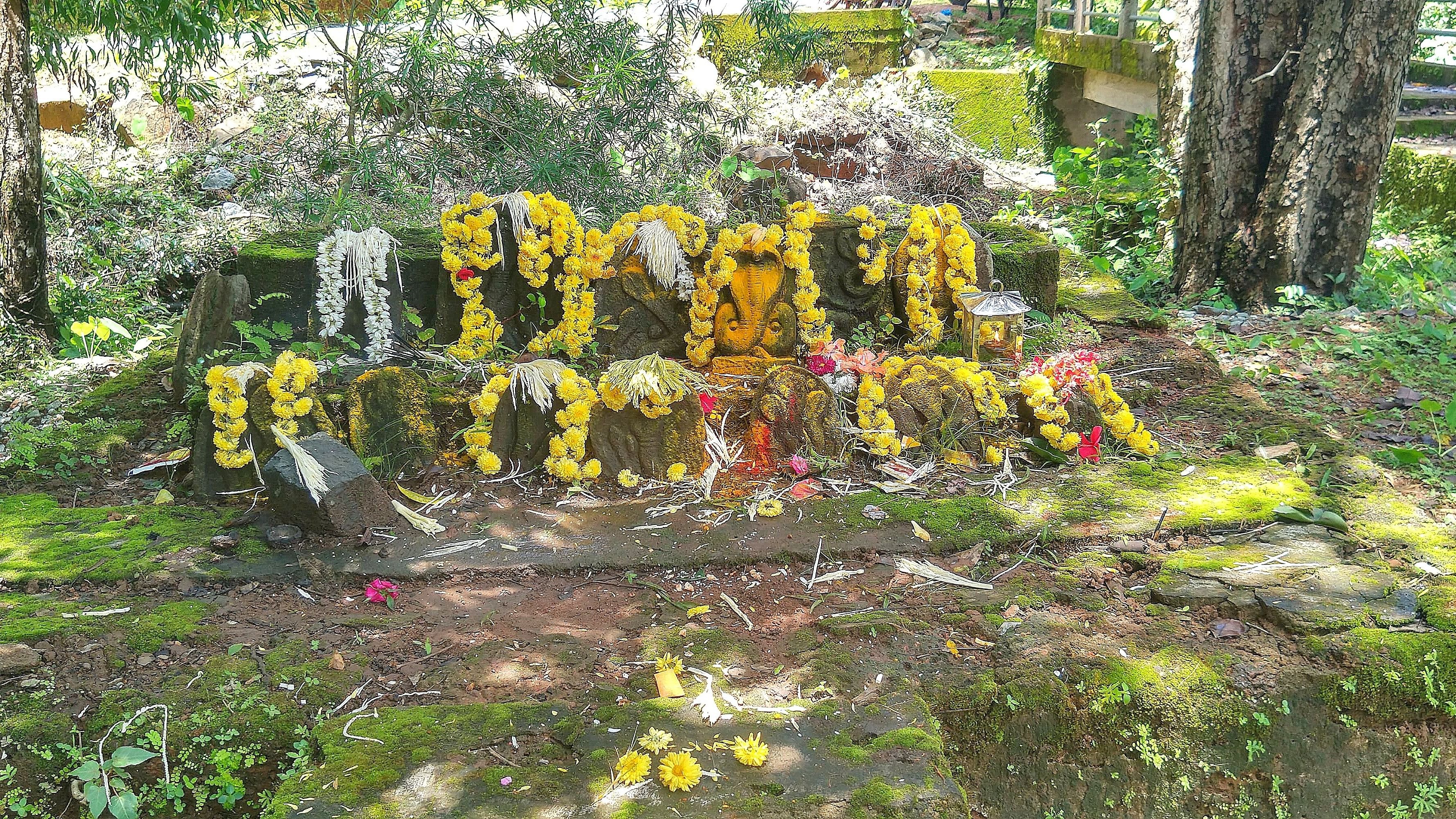
Serpent stones adorned with flowers in Byndoor of Udupi district; a 'moola nagabana' in Kundapur.
Credit: DH Photo/Santhosh Mogavira
Tulunadu’s tradition of ‘Nagaradhane’, or worshipping the serpent deity, has developed over the ages. The region sees various traditions that involve the worship of elements of nature. Nagaradhane is not confined to the coastal region. However, worshipping a serpent in the form of the six-faced Subrahmanya is peculiar to the coast.
Matriarchal communities of Tulunadu, such as the Bunt community, revere Naga as the main deity. They pay obeisance at their 'moola thana', the original serpent grove of the respective clan. Some families may also observe rituals at their family's nagabana or sacred grove. This is due to the non-traceability of the original nagabana due to migration.
Sacred groves (also known as ‘devarakadu', 'bhoothabana', 'kanu' or 'pavitra vana') are forests devoted to certain deities (daiva). Those devoted to the serpent deity are known as serpent groves or 'nagabana'. They support the biodiversity of plants, mammals, birds, worms, reptiles and sources of water.
Shrinking of sacred groves
Credit: DH Photo/Santhosh Mogavira
In a study on the sacred groves of coastal Karnataka, researchers Prabhakar Achar, Vidya Nayak and their team have documented 294 plant species found in sacred groves. They include ashwattha (Ficus religiosa), dhoopa (Vateria indica) and amritha balli (Tinospora cordifolia). They are also home to 22 types of mammals, including the bonnet macaque, slender loris, small Indian civet, striped hyena and spotted deer. In addition, 55 bird varieties have been recorded in groves, like the little cormorant, cattle egret and barn owl, as well as 18 types of reptiles including the Indian pond terrapin, flying lizard and Russell’s viper.
These groves are generally spread across acres of land, but have been shrinking due to encroachment. This has led to a huge loss of biodiversity.
The forests that were once homes of reptiles, including serpents, were later converted into human habitations and agricultural lands, says Thukaram Poojary, retired history professor and founder chairman of the Rani Abbakka Tulu Adhyayana Kendra and Tulu Baduku museum in Bantwal.
“In ancient times, humans revered the presence of serpents, with which they co-existed. This was true to ancient Tulunadu as well. But today, people consider reptiles a threat,” he adds.
Serpents reside in cool temperatures. But today, concrete and cement structures covered with tin sheets have replaced the natural canopy in nagabanas, he explains.
The deity of the serpent is also associated with agriculture. There is an ancient belief in Tulunadu that a serpent will not disturb the land where a plough has passed.
Nagabanas, which house anthills, are known to be a good source of groundwater. The termites can be found up to 100 feet beneath the ground. During rains, the anthills act as groundwater recharging chambers. Earlier, one could find anthills in nagabanas. Several nagabanas have now been converted into concrete jungles, and there is no scope for percolation of water, says Thukaram.
It is also a norm in Tulunadu that establishments should not be built on a nagabeedhi. A nagabeedhi refers to the places where serpent movements have been found or are known to have been found in the past.
Tracing history
Credit: DH Photo/Santhosh Mogavira
Even though it is difficult to trace the exact time when Naga worship started, rituals followed by the tribal communities indicate that the deity was one of the ancient gods worshipped in the region. Tribal communities have preserved the sacred groves in their original form in many regions.
Veteran researcher Indira Heggade says, “Nagarapanchami is normally observed during the Shravana month of the lunar calendar in most regions, that time is the month of Aati for Tulunadu.”
In Padukudoor village in Karkala taluk, Udupi district, folk songs are sung in praise of the king cobra. Clay pots are offered by devotees in fulfilment of their vows. In another ritual known as 'kaadya darshana', the priest answers the questions of the devotees.
Several rituals are devoted to the serpent deity, including ‘naga tambila’, 'ashlesha bali’, ‘sarpa samskara’ and ‘nagamandala’.
Among these, nagamandala involves an elaborate ritual, known to be one of the most auspicious. Here, devotees perform dances around an elaborately drawn mandala, in the backdrop of nagaswara and drum beats. The ritual is held through the night.